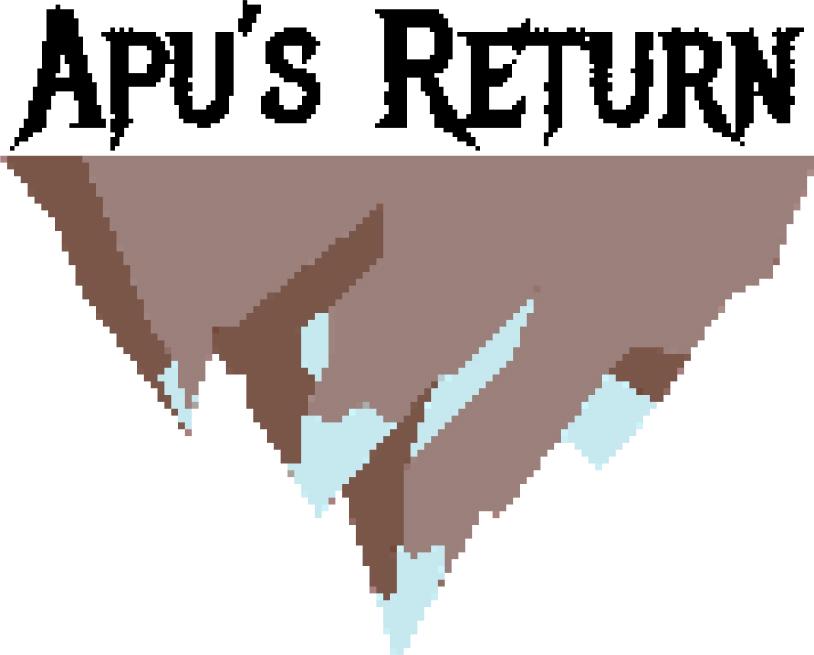Luc Alvarez, James Chao, Valeria Wu Fon, Dria Lee, Daphne Wilkerson
CS 247G — P2-18
Link to game: https://drive.google.com/drive/folders/12R5EiXidSeafRqMbSguI7IDjjdIG20AK?usp=sharing
Artist’s Statement
Apu’s Return is a narrative-driven puzzle platformer where the player is immersed into the Incan Empire as the God Apu who has been stripped of their powers for being too much of a threat to the other Incan Gods. As they navigate through a variety of terrains, beginning in the jungle and ending in a temple atop Machu Picchu, the player gains back their powers one-by-one, adding to their combat arsenal and ability to platform. Along the way, more and more of their past is revealed, motivating Apu’s path to vengeance.
In drawing inspiration from similar platformers, we’ve created a game that feels familiar but with interesting modifications through Godly powers and cohesive theming that helps to immerse the player in this world that has so far been underrepresented in the game industry. The art is in 16-bit, bringing back nostalgia from old platformers, but still in a high enough fidelity to bring the player into the world. Apu’s Return is a challenging, ever-changing platformer allowing the player to explore a world unfamiliar to them, but true to Incan culture. Given the content and difficulty, we’re targeting older gamers in high school through adulthood, ideally with some past experience in platformers, although through our onboarding process, anyone is still able to play our game and have fun.
Model of System
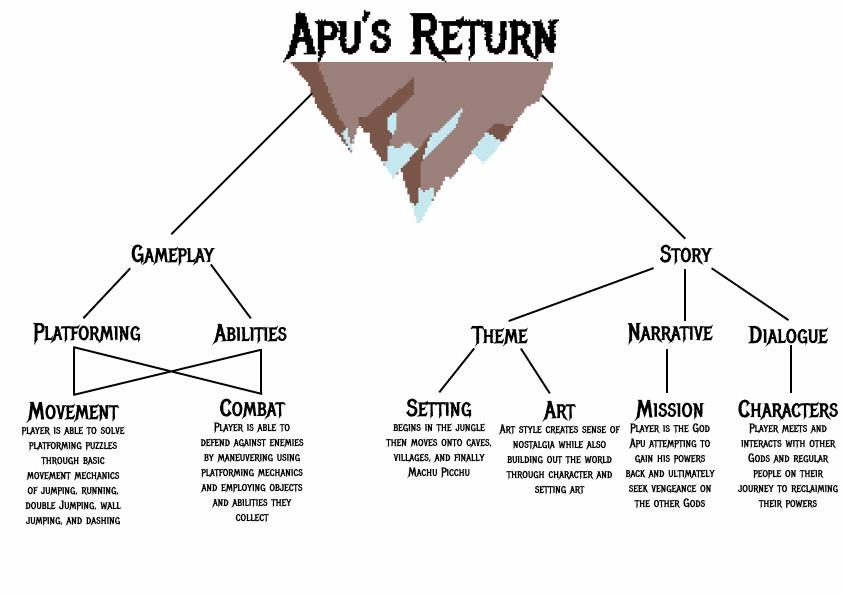
Initial decisions about formal elements and values
In our initial brainstorm, we discussed both gameplay and narrative. Gameplay-wise, we settled early on that we wanted to create a fully digital platformer over our shared love of gameplays like Super Mario, Jetpack Joyride, and Temple Run. That said, we wanted to ensure that we went beyond just the typical, very-basic platformer experience by adding layers of challenging puzzles and gameplay mechanics to appeal to an older, more experienced gaming audience.
As far as narrative, we wanted to create an experience very different from players’ everyday experiences, allowing for them to enter into a world of escape. Valeria proposed the idea of placing the world in the Incan Empire and having the player play as a God — something that she could pull personal cultural knowledge from to ensure our game is true to their culture. By placing our game within the Incan Empire, we were then able to draw on Incan mythology to bring out fantasy elements, resulting in abilities being granted to the player throughout the game as they amass their powers back. All of the characters we designed and named are based on true Incan mythology.
Game Architecture and Narrative
In fleshing out this narrative, we were able to build out a full-game arc, rather than the traditional, at-times repetitive loops in many platformers. Given our choice to appeal to older audiences rather than young kids, we knew that we couldn’t rely on having our gameplay be as simple as something like Temple Run where every game is the exact same. Instead, we use loops and arcs in tandem, with the gameplay feeling familiar as the player gets a grasp for the controls, but the arcs make the player feel like they’re building towards something bigger, motivating further play and making the overall experience more immersive.
Thus, we saw that we could marry both game mechanics and narrative to create a cohesive platforming experience that’s genuinely interesting and fun to the user. Through this, players would have a motivation to continue the story and further explore the world as they look to unlock new abilities by completing levels. Through this realization, we landed on our final narrative idea: to have the player play as a God that’s lost their powers, seeking to get them back. To reclaim these powers, they would have to go through a series of platforming puzzles and as they unlock new powers, they would be able to complete platforming challenges and combat they wouldn’t be able to do before, keeping the gameplay fresh and the narrative progressing.
Formal Elements of the Game
With this in mind, we can now examine our original formal elements of the game. Our game is a single-player game in a Player Vs. Environment setup with them playing as the Incan God Apu. Their high-level objective is to reclaim their abilities and regain their original power back, which is accomplished in chunks by completing platforming puzzles and navigating through combat. The God Apu is presented with obstacles like flying darts, lava, and enemies that prevent him from navigating the terrain smoothly.
The first aesthetic we had in mind was challenge. We wanted to accomplish this at multiple levels, starting with the mechanism of lava. The dynamic that the Apu has with the lava is that if touched, Apu has to return to the latest checkpoint and re-do that puzzle of the platform again. A similar mechanism that is introduced as the game goes on is the flower darts, that have been programmed with the dynamic of trying to hit Apu as he traverses through the world. Similar to the lava, if touched by the darts, Apu has to return to the latest checkpoint and re-do the puzzle. Since lava is very popular in other platform games commonly associated with negatives (like the Plants v Zombies video suggested), it was going to feel like an intuitive challenge for the player at the beginning.
A second aesthetic presented was narrative. As previously mentioned, our whole platform is themed and scripted based off Incan mythology. To make sure the narrative was clear from the beginning, we added the dynamic of dialogue between characters at the beginning and through the platform game so that the new player can understand the characters, the objective of the game, and how it needs to traverse through the world. We start explaining that Apu has lost his powers, and that he needs to find the shaman. Once he finds the shaman, the shaman instructs that to regain his powers he needs to find a shield (and so on). This feature of dialogue really allows the player to be immersed in the next challenge that appears.
A third aesthetic we wanted to create was discovery. We didn’t want the platformer to only have one right answer or way to move through the world. This is why the mechanisms of jumping and running are helpful because even if the player can’t figure out how to traverse the world at first try, they can explore the multiple ways of jumping around to get around the obstacle. Which is why we added the dynamic of dashing, wall jumping, and double jumping, to give the player even more optionality as to how they could move from one place to another. With these 3 important types of fun to shoot for, we set on to design our first iteration of our platform game.
Lastly, we decided as a team our values for P2. Since we were placing our game within the Incan Empire, we wanted to ensure we weren’t simply appropriating their culture for fun and instead be as true to it as possible. This was aided by our teammate Valeria’s knowledge of the culture guiding our design process given her cultural background. Through this, we wanted to create an experience that pushes what players think of platformers and games in general. By incorporating a culture left out from the game industry, we want to show that there’s many more stories to be told than the ones currently found in Triple A game studios — ones that can highlight the full range of human experience, expose individuals to new cultures, and generate interest for more cultural exchange.
Testing and Iteration History
Initial Design — With a team of 5 individuals that had zero experience in game development, our initial game was much of us simply figuring out how to build in Godot. As such, we walked through a series of tutorials and built out a basic level that demonstrated a proof-of-concept for walking, jumping, double jumping, dashing, and wall jumping. Despite much of the initial design being pulled from tutorials, the core mechanics of our gameplay would ultimately be built out in this phase as we continued to receive positive feedback throughout the design process.
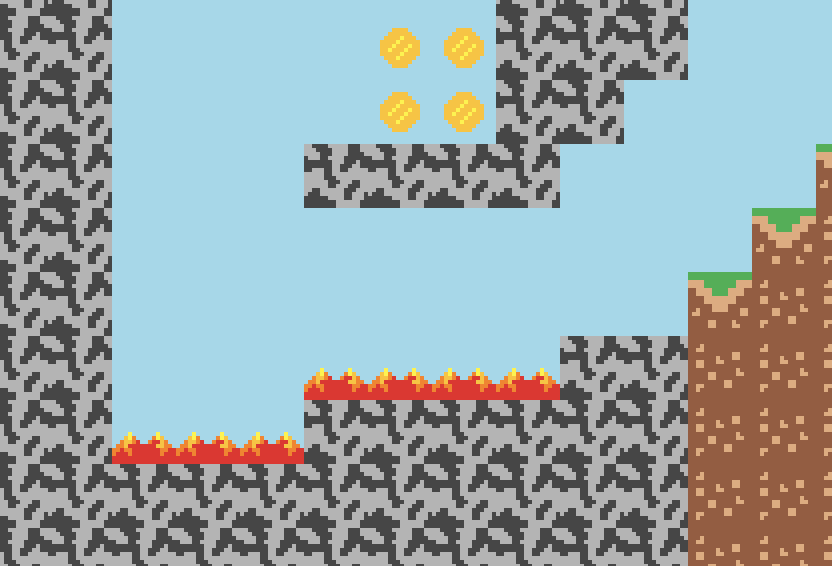

Original tiles from first iteration.
This difficulty mapping was something we kept in mind throughout the entire project as we want to ensure that while we’re creating a game that feels satisfyingly difficult, we’re not creating unnecessary frustration too early on. While playtesting with our own team doesn’t present the same perspective as a true newcomer, we were still able to make sure our levels were possible and that the game was bug-free before our first playtest.
First Playtest, Proof of Concept — In this playtest, we essentially tested whether our game worked and was intuitive enough to be picked up by a player. We had a basic level design with no real climax, instead just some platforming to test out the game mechanics and whether they could be entertaining and understood to our target audience. Some guiding questions were: a) How well can the player grasp the basic movement mechanics with the keyboard without too much instruction? b) Does the player have a sense of intuitive direction of where the game is moving? c) How difficult is it for the player to maneuver more complex puzzles as the game advances?
Aside from this difficulty “fork,” we also gathered some other feedback from the playtest. First was some confusion about what the coins were for. We had no tracker showing an accumulation of coins and instead used them to just serve as checkpoints for progress. This iteration was without a theme so finding a way to incorporate checkpoints in a way that made sense was something we kept in mind going forward. Secondly, we also found that some of our level design was confusing. While some sections were challenging because they required creativity or skillful maneuvering, there were some sections that felt misleading and led the playtester into deadends. This was ultimately a negative experience and didn’t lead to satisfaction once they found the right way, just annoyance and confusion in the process. Overall, we recognized a need for a more in-depth onboarding process that gives the player a longer on-ramp to build competence as well as the need for more instructions on key gameplay mechanics. Additionally, we saw that we would need to change some of the level design to work with the user, rather than needlessly lead them away from a solution.
That said, in this iteration we were able to test the primary aesthetic of our game — challenge — to see if we were fulfilling this goal. Even without the narrative arc that would be implemented later in the game, the puzzle-solving platforming loops were engaging enough to keep our playtester engaged. We also saw that they recognized the objective of the game without needing added narrative motivations or explicit instructions. This isn’t to say that both aren’t important or that we wouldn’t incorporate them later, but that the game was intuitive enough to be picked up quickly.
We knew that in this phase, the tiles would ultimately be swapped out for something more on-theme, but we still received positive feedback from players on the general art style and fidelity of the level design, showing that our plan of continuing the 16-bit aesthetic would have success in future iterations. We ended up using the same platform, pixilart.com, to hand-create the rest of the tiles found in further iterations of the game.
Second Playtest, Early Theming — In this iteration, we added some theming to our game by placing the setting in the jungle, changing the character to an Incan God, and redid the level design. Our main guiding questions were a) How well does the player understand and receive the aesthetic of fantasy through our rebranding? b) How challenging do the newer parts of our levels feel as the player finds out about new movements? c) Do they feel empowered by the narrative and motivation to play the game?
We got generally positive feedback on these elements as they added a layer of intrigue, but in this playtest we again focused mainly on the core gameplay driving the game. Going forward, we knew that we would end up adding in more theme elements such as dialogue, a fleshed out story, and more specific setting elements like a temple, so getting a positive reception to the limited theme elements was a good sign as they all contributed towards our goal of narrative fun.
After playing for a couple of minutes, our playtester found the controls to mostly make sense (at the time, left and right were mapped to A and D respectively and Space was used to jump). The first few platforms were done with relative ease, but once multiple maneuvers were required, we ran into some dexterity issues. Specifically, in a section that requires the player to double jump and then wall jump off a wall and onto a platform, it took the playtester upwards of 10 trials to complete this task. Later in the same sequence, they were required to do the same maneuver but with the added layer of a final dash which again took several tries to complete.
Overall, as a first trial, we felt like the playtest was a success. Our game was intuitive and interesting enough to keep the playtester through the level, although we saw some early signs of there being different categories of players: experienced and inexperienced. The playtester we had try out this first iteration of the game had some exposure to past platformers but didn’t consider themself a true “gamer.” As such, they didn’t have the same muscle memory or quick reflexes that some of us had when we tried out the game. This segmentation of users is something we would consistently run into throughout our playtesting with varying levels of success from players being highly dependent on their past experience with similar games.
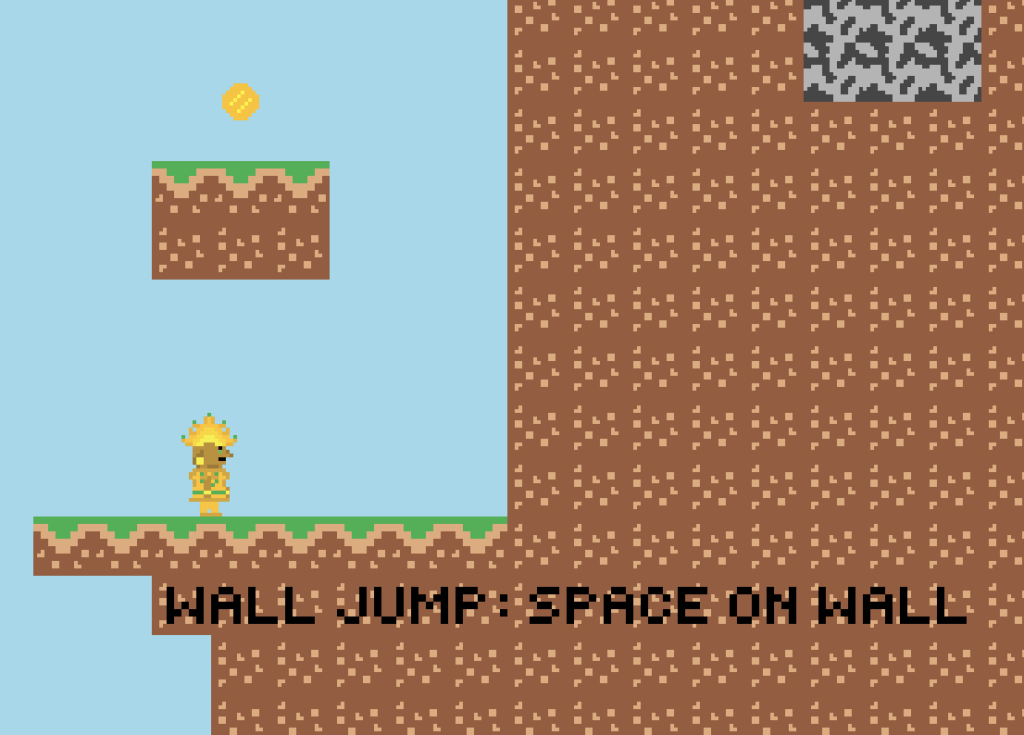
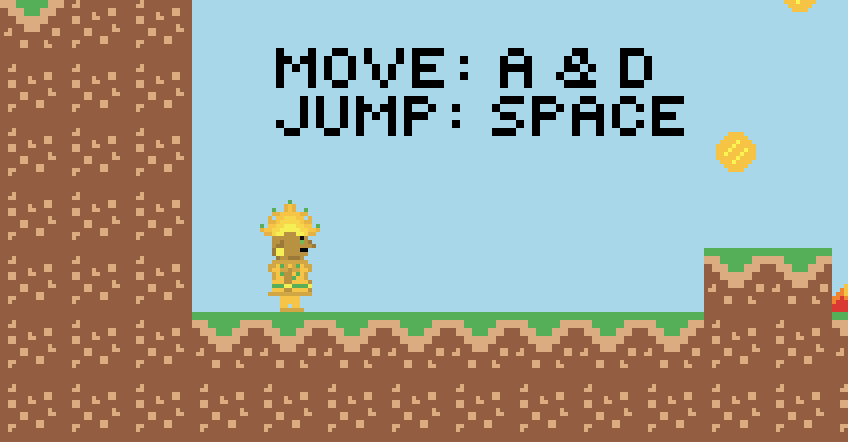
Players in the first test reported the game being difficult but satisfying and largely intuitive through instructions.
Aside from this difficulty “fork,” we also gathered some other feedback from the playtest. First was some confusion about what the coins were for. We had no tracker showing an accumulation of coins and instead used them to just serve as checkpoints for progress. This iteration was without a theme so finding a way to incorporate checkpoints in a way that made sense was something we kept in mind going forward. We also found that some of our level design was confusing. While some sections were challenging because they required creativity or skillful maneuvering, there were some sections that felt misleading and led the playtester into deadends. This was ultimately a negative experience and didn’t lead to satisfaction once they found the right way, just annoyance and confusion in the process. Overall, we recognized a need for a more in-depth onboarding process that gives the player a longer on-ramp to build competence as well as the need for more instructions on key gameplay mechanics. Additionally, we saw that we would need to change some of the level design to work with the user, rather than needlessly lead them away from a solution.
That said, in this iteration we were able to test the primary aesthetic of our game — challenge — to see if we were fulfilling this goal. Even without the narrative arc that would be implemented later in the game, the puzzle-solving platforming loops were engaging enough to keep our playtester engaged. We also saw that they recognized the objective of the game without needing added narrative motivations or explicit instructions. This isn’t to say that both aren’t important or that we wouldn’t incorporate them later, but that the game was intuitive enough to be picked up quickly.
We knew that in this phase, the tiles would ultimately be swapped out for something more on-theme, but we still received positive feedback from players on the general art style and fidelity of the level design, showing that our plan of continuing the 16-bit aesthetic would have success in future iterations. We ended up using the same platform, pixilart.com, to hand-create the rest of the tiles found in further iterations of the game.
Second Playtest, Early Theming — In this iteration, we added some theming to our game by placing the setting in the jungle, changing the character to an Incan God, and redid the level design. We got generally positive feedback on these elements as they added a layer of intrigue, but in this playtest we again focused mainly on the core gameplay driving the game. Going forward, we knew that we would end up adding in more theme elements such as dialogue, a fleshed out story, and more specific setting elements like a temple, so getting a positive reception to the limited theme elements was a good sign as they all contributed towards our goal of narrative fun.
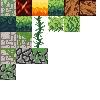
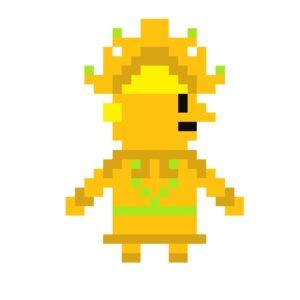
In this iteration, we began including themed elements such as redesigned tiles and a new character.
When first approaching the design of our main character, we chose to replicate the Incan God Viracocha. Viracocha is the creator deity who was believed to have created the Sun and the Moon. To create his character, we got inspiration from Incan artwork on the internet, and created his character surrounding a golden theme, with a golden headpiece and jewelry. We ultimately swapped out this character to Apu, the Incan God of the Mountains for narrative reasons in order to make the story of being kicked out by other gods make more sense. This was because it wouldn’t make sense to have a narrative where the ultimate God got kicked out of the pantheon, it had to be a God that was of second most importance.
These additions tested another major aesthetic of our game — narrative. This was our first attempt at embedding story elements and theming into the game. We got positive feedback on these attempts from users as they appreciated the different story that was being told through the game, although they pointed out that at this point it felt lacking in depth. This was prior to adding in dialogue or later parts in the level where the player interacts with other characters, so we were mainly gauging players’ reactions to the premise and art style. Ultimately, our takeaway was that we were on the right track but would need to push further.
A major point of feedback we received was in the controls feeling clunky. The user said they expected to be able to use all WASD instead of just A and D which presented some confusion as we deviated from the norms of other games. They also found that some controls specific to our game were confusing with a relatively short tutorial section. They appreciated the background text being a subtle set of instructions and then immediately being able to test out their abilities, but felt that the difficulty ramped up too much before they got a hang of it. Lastly, they found that the instakill homing darts we added into the game made the already difficult game way too difficult and feel unfair at times. The flowers shooting darts had no limit to their range so there was a constant onslaught of darts at all times that tracked the player, adding a layer of difficulty onto the already challenging platformer that was new to the player.
From this playtest, we again got feedback that the game felt difficult, but the player did say that the challenge felt rewarding and satisfying when they made it through. The only unfair aspect of the game felt like the darts. That said, we saw the need for a more extended onboarding to allow the user to grasp the controls more before throwing them in the deep end. In particular, some of the nuances to the game like how dashing, double jumping, and wall jumping work with each other and whether you can do one after another need chances to be explored by the user. This feedback is something we took into consideration as we sought to redesign aspects of our level.
In this iteration, we also changed our level design in order to match it more closely with our jungle setting, as well as try out some new puzzle designs. We found that these sections of the level felt more like puzzles than platformers as the solutions are less obvious for the player. Players agreed with this assessment as they felt like they were being pushed to think creatively about how to solve parts of the level, beyond just speedrunning like they would in other platformers. And while this did mark an improvement in pushing us towards a stronger final product for our target audience or more mature players, we did see that in order to present players with these challenges, they required more onboarding and chances to experiment before we threw them in the deep end.
Playtest 3, refined prototype — This was among our final playtests wherein we wanted to make sure that all of our mechanics were operating correctly, the level design made sense, and the theme added a layer of interest from our players. Some leading questions for this third prototype were a) How do the full game mechanics feel for the player? Do they feel overwhelmed or just the right amount of challenge? b) How do they feel about the hints and added dialogue to foster narrative and fantasy?
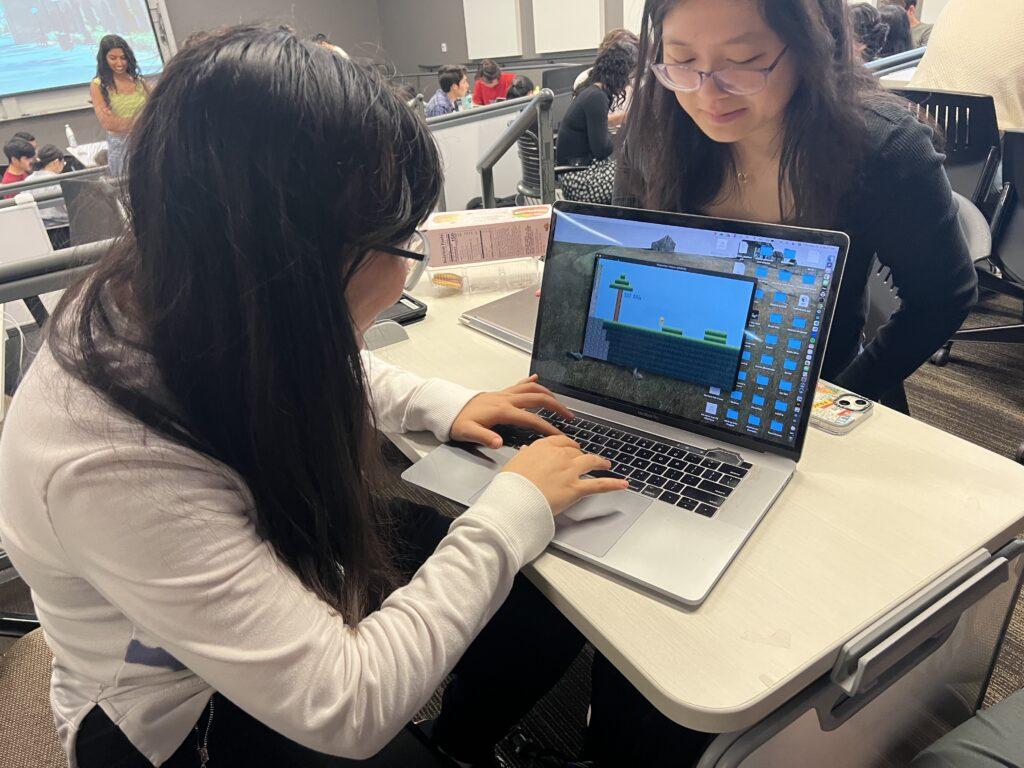
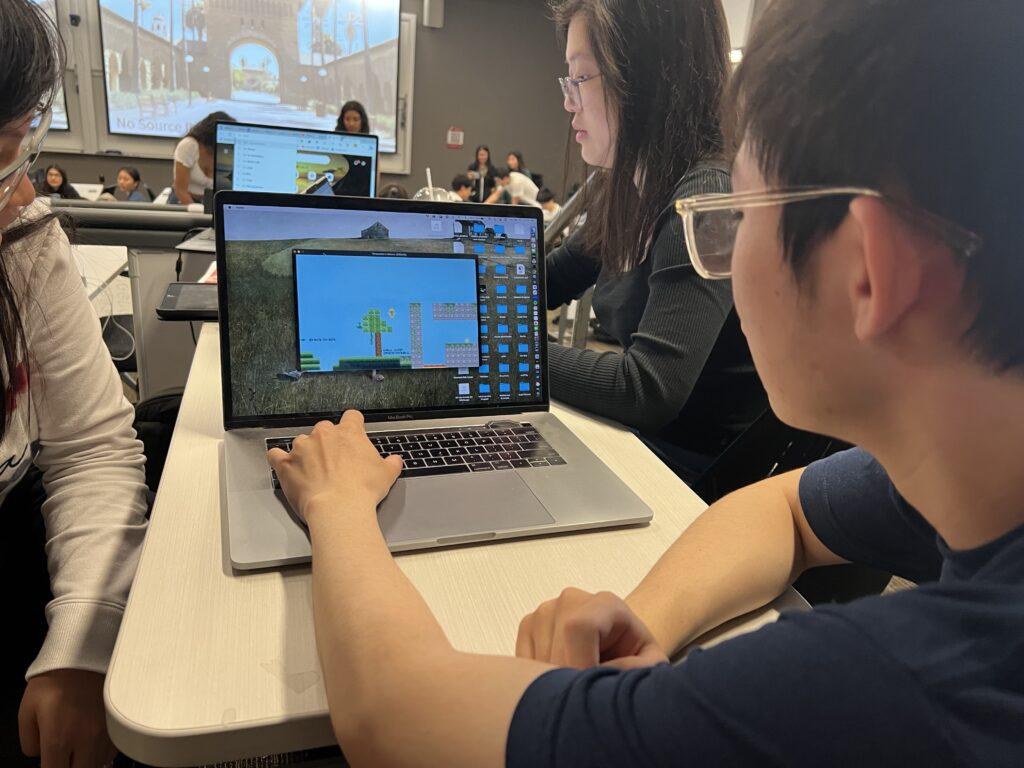
These additions tested another major aesthetic of our game — narrative. This was our first attempt at embedding story elements and theming into the game. We got positive feedback on these attempts from users as they appreciated the different story that was being told through the game, although they pointed out that at this point it felt lacking in depth. This was prior to adding in dialogue or later parts in the level where the player interacts with other characters, so we were mainly gauging players’ reactions to the premise and art style. Ultimately, our takeaway was that we were on the right track but would need to push further.
A major point of feedback we received was in the controls feeling clunky. The user said they expected to be able to use all WASD instead of just A and D which presented some confusion as we deviated from the norms of other games. They also found that some controls specific to our game were confusing with a relatively short tutorial section. They appreciated the background text being a subtle set of instructions and then immediately being able to test out their abilities, but felt that the difficulty ramped up too much before they got a hang of it. Lastly, they found that the instakill homing darts we added into the game made the already difficult game way too difficult and feel unfair at times. The flowers shooting darts had no limit to their range so there was a constant onslaught of darts at all times that tracked the player, adding a layer of difficulty onto the already challenging platformer that was new to the player.
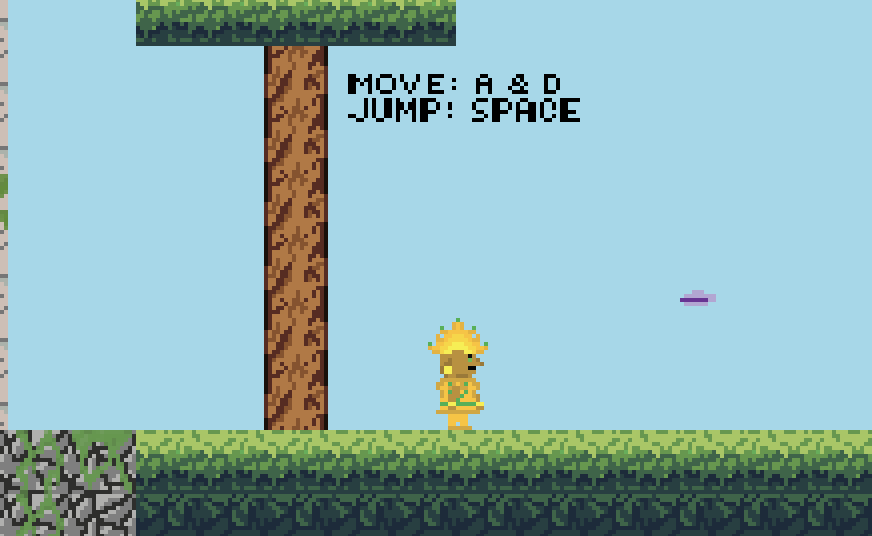
The limitless darts were a major pain point in this iteration as they added a layer of difficulty that frustrated players, rather than leaving them feeling challenged.
From this playtest, we again got feedback that the game felt difficult, but the player did say that the challenge felt rewarding and satisfying when they made it through. The only unfair aspect of the game felt like the darts. That said, we saw the need for a more extended onboarding to allow the user to grasp the controls more before throwing them in the deep end. In particular, some of the nuances to the game like how dashing, double jumping, and wall jumping work with each other and whether you can do one after another need chances to be explored by the user. This feedback is something we took into consideration as we sought to redesign aspects of our level.
In this iteration, we also changed our level design in order to match it more closely with our jungle setting, as well as try out some new puzzle designs. We found that these sections of the level felt more like puzzles than platformers as the solutions are less obvious for the player. Players agreed with this assessment as they felt like they were being pushed to think creatively about how to solve parts of the level, beyond just speedrunning like they would in other platformers. And while this did mark an improvement in pushing us towards a stronger final product for our target audience or more mature players, we did see that in order to present players with these challenges, they required more onboarding and chances to experiment before we threw them in the deep end.
Playtest 3, refined prototype — This was among our final playtests wherein we wanted to make sure that all of our mechanics were operating correctly, the level design made sense, and the theme added a layer of interest from our players.

For this iteration, we added the characters of other Gods to further develop our narrative. Our player would be able to interact with these Gods and their dialogue would appear on the screen. The dynamic of dialogue was going to help with the onboarding, but as well with the fantasy element and motivation.
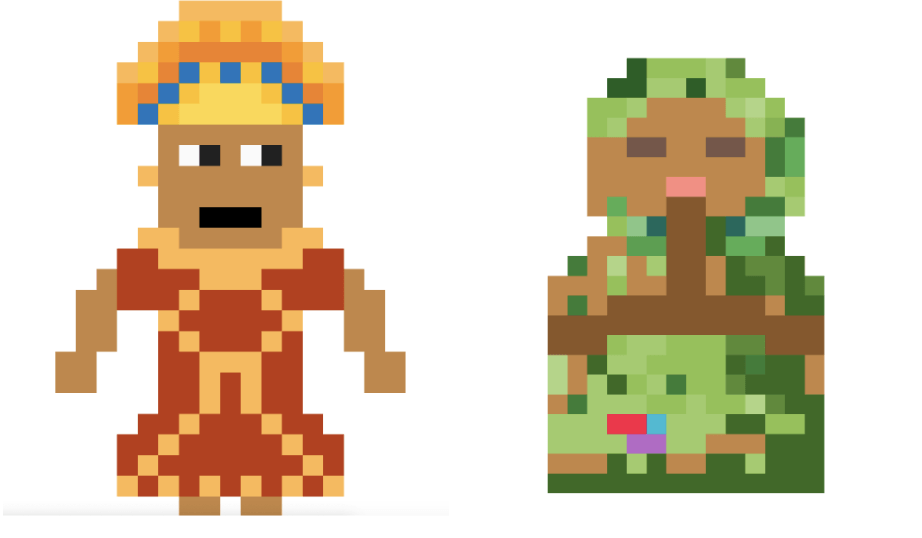
We chose to design Inti, the ancient Inca Sun God, and Pachamama, the Incan God of “Mother Earth”. When designing these characters, we chose a color scheme that matched the themes of each God. We chose a variety of greens to represent the trees on Pachamama, and a hint of pink and purple as flowers on the hills of her body. Her skin tone is brown to match the mountains. We created Inti’s headpiece to mirror the sun, with different shades of yellow and blue to create depth and show power. Like Apu, he also wears distinct gold jewelry to represent his deity.
One major note we found was that we were still underperforming in onboarding the player. In some areas, there was a lack of reinforcement for successfully completing a maneuver and instead it felt like the game was progressing too quickly. There was also an instance where a hint wasn’t seen by the user due to it being black text on a dark gray background. Lastly, we found that the user simply didn’t know what move combinations to perform in a challenging part of the level and had to be helped through. All of these are addressable and ones we sought to remedy in our final prototype, however, they again gave a clear indication that among less experienced players, our game would be especially challenging.
At this point, we saw a decision to make as the initial difficulty “fork” we saw before presented itself again. In going back to our original target audience, we ultimately opted to cater more towards experienced gamers, rather than complete newcomers. In doing so, we felt that we would ultimately be able to create an experience that’s highly engaging for serious platformers through difficult puzzles. In doing so, we also believe that with some improvements to the onboarding, we’d be able to ensure new players aren’t totally alienated, and that while they may have added difficulty in completing levels, they’d also get to play a game that was fun for them.
We also discovered a bug in our game where when players were shot with a dart, they were brought all the way to the start, rather than to the last checkpoint. This added a layer of confusion and frustration for the user where they felt like they lost all of their progress for something out of their control. This was solved in our next iteration.
We chose to design Inti, the ancient Inca Sun God, and Pachamama, the Incan God of “Mother Earth”. When designing these characters, we chose a color scheme that matched the themes of each God. We chose a variety of greens to represent the trees on Pachamama, and a hint of pink and purple as flowers on the hills of her body. Her skin tone is brown to match the mountains. We created Inti’s headpiece to mirror the sun, with different shades of yellow and blue to create depth and show power. Like Apu, he also wears distinct gold jewelry to represent his deity.
One major note we found was that we were still underperforming in onboarding the player. In some areas, there was a lack of reinforcement for successfully completing a maneuver and instead it felt like the game was progressing too quickly. There was also an instance where a hint wasn’t seen by the user due to it being black text on a dark gray background. Lastly, we found that the user simply didn’t know what move combinations to perform in a challenging part of the level and had to be helped through. All of these are addressable and ones we sought to remedy in our final prototype, however, they again gave a clear indication that among less experienced players, our game would be especially challenging.
At this point, we saw a decision to make as the initial difficulty “fork” we saw before presented itself again. In going back to our original target audience, we ultimately opted to cater more towards experienced gamers, rather than complete newcomers. In doing so, we felt that we would ultimately be able to create an experience that’s highly engaging for serious platformers through difficult puzzles. In doing so, we also believe that with some improvements to the onboarding, we’d be able to ensure new players aren’t totally alienated, and that while they may have added difficulty in completing levels, they’d also get to play a game that was fun for them.
We also discovered a bug in our game where when players were shot with a dart, they were brought all the way to the start, rather than to the last checkpoint. This added a layer of confusion and frustration for the user where they felt like they lost all of their progress for something out of their control. This was solved in our next iteration.
Altogether, this playtest was again an example of an inexperienced player struggling to easily adapt to the game. That said, we did have a positive reception from them as they said they would continue playing and that the difficulty was satisfying once completed, but that without the help of us she probably would have given up at some point. The major takeaways from this playtest was again that at the core of our game, we have rewarding gameplay that keeps players hooked, but that without more hints and onboarding, we would be pushing some potential players away that lacked prior exposure to platformers.
In assessing our 3 key aesthetics we were hoping to incorporate, we did see that we were having success in all aspects. Through challenging puzzles that took both physical skill to maneuver and cognitive planning, players felt like they were embarking on satisfying challenges. We saw interest in the narrative aesthetic from our players as they again noted that they hadn’t played a game in this setting before and would be interested in seeing where the story progresses. As for discovery, by placing players in tough challenges as part of our level design, we saw creativity employed and moments of realization as they discovered ways in which they could combine their abilities to complete puzzle sections of the game.
Final Playtest, available on YouTube https://www.youtube.com/watch?v=msW_BFv-QnY — In our final playtest, we sought out an experienced platformer to test our hypothesis that among those with gaming experience, they’d find the game’s difficulty curve much more manageable. This hypothesis was found to be true as our playtester was successfully onboarded and completed the difficult level in under 7 minutes with almost no hinting. We received positive feedback from both our playtester in the video as well as others that tried the game who all agreed that while the game was difficult, the challenge was ultimately satisfying through smooth mechanics that build together in interesting ways to solve a series of platforming puzzles. Through the addition of dialogue, players said they also felt like what they were doing had a purpose as they both wanted to complete the level, but also progress the story to reveal more of the narrative. Both of these types of fun led to a sense of discovery about how the game operates and the story it’s telling, all built through small elements such as dialogue with NPCs, combinations of jumping, double jumping, dashing, wall jumping, and our latest addition — a shield that allows players to surf on lava and protect from poison darts.
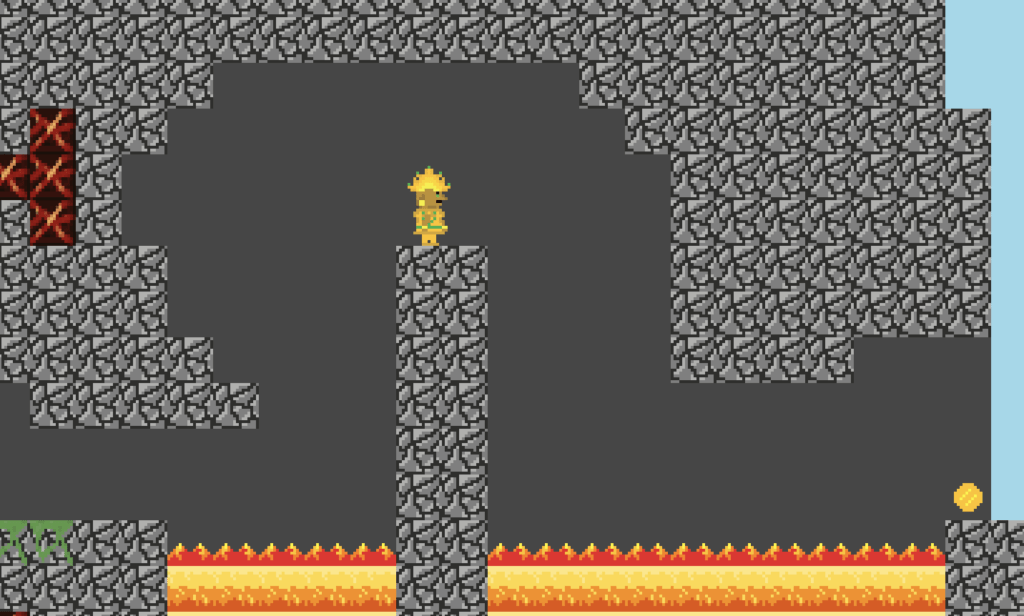

These two specific parts of the level were reported as exceptionally challenging and somewhat confusing by players in this round of playtesting.
Altogether, this playtest was again an example of an inexperienced player struggling to easily adapt to the game. That said, we did have a positive reception from them as they said they would continue playing and that the difficulty was satisfying once completed, but that without the help of us she probably would have given up at some point. The major takeaways from this playtest was again that at the core of our game, we have rewarding gameplay that keeps players hooked, but that without more hints and onboarding, we would be pushing some potential players away that lacked prior exposure to platformers.
In assessing our 3 key aesthetics we were hoping to incorporate, we did see that we were having success in all aspects. Through challenging puzzles that took both physical skill to maneuver and cognitive planning, players felt like they were embarking on satisfying challenges. We saw interest in the narrative aesthetic from our players as they again noted that they hadn’t played a game in this setting before and would be interested in seeing where the story progresses. As for discovery, by placing players in tough challenges as part of our level design, we saw creativity employed and moments of realization as they discovered ways in which they could combine their abilities to complete puzzle sections of the game.
Final Playtest, available on YouTube https://www.youtube.com/watch?v=msW_BFv-QnY — In our final playtest, we sought out an experienced platformer to test our hypothesis that among those with gaming experience, they’d find the game’s difficulty curve much more manageable. This hypothesis was found to be true as our playtester was successfully onboarded and completed the difficult level in under 7 minutes with almost no hinting. We received positive feedback from both our playtester in the video as well as others that tried the game who all agreed that while the game was difficult, the challenge was ultimately satisfying through smooth mechanics that build together in interesting ways to solve a series of platforming puzzles. Through the addition of dialogue, players said they also felt like what they were doing had a purpose as they both wanted to complete the level, but also progress the story to reveal more of the narrative. Both of these types of fun led to a sense of discovery about how the game operates and the story it’s telling, all built through small elements such as dialogue with NPCs, combinations of jumping, double jumping, dashing, wall jumping, and our latest addition — a shield that allows players to surf on lava and protect from poison darts.
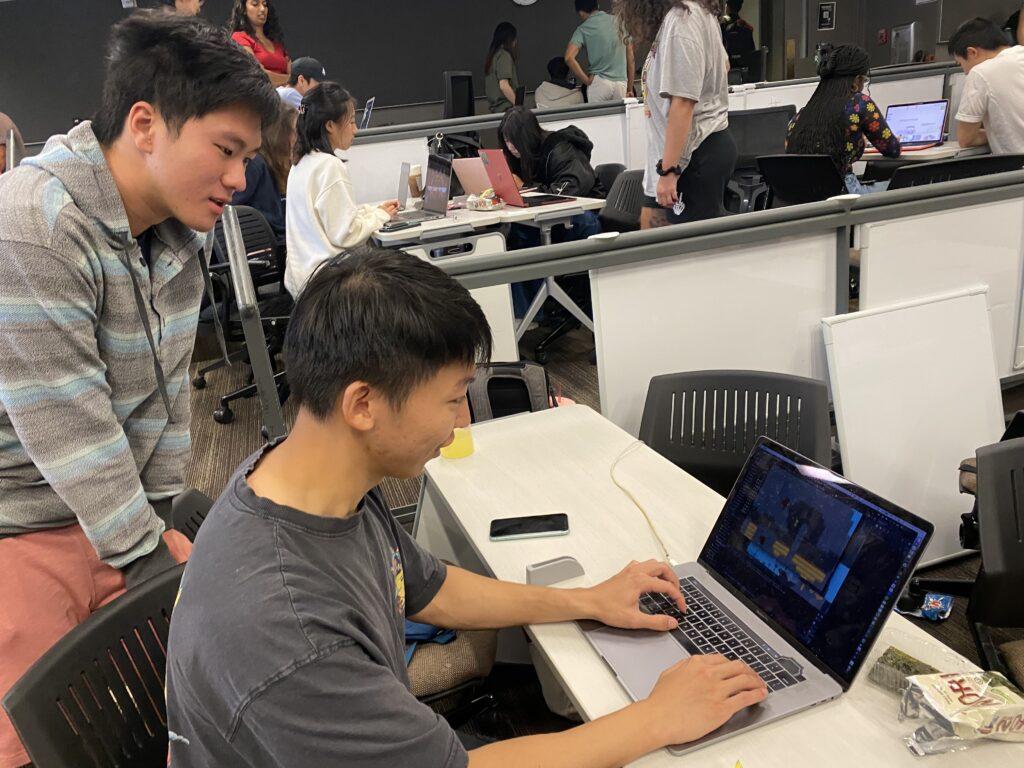
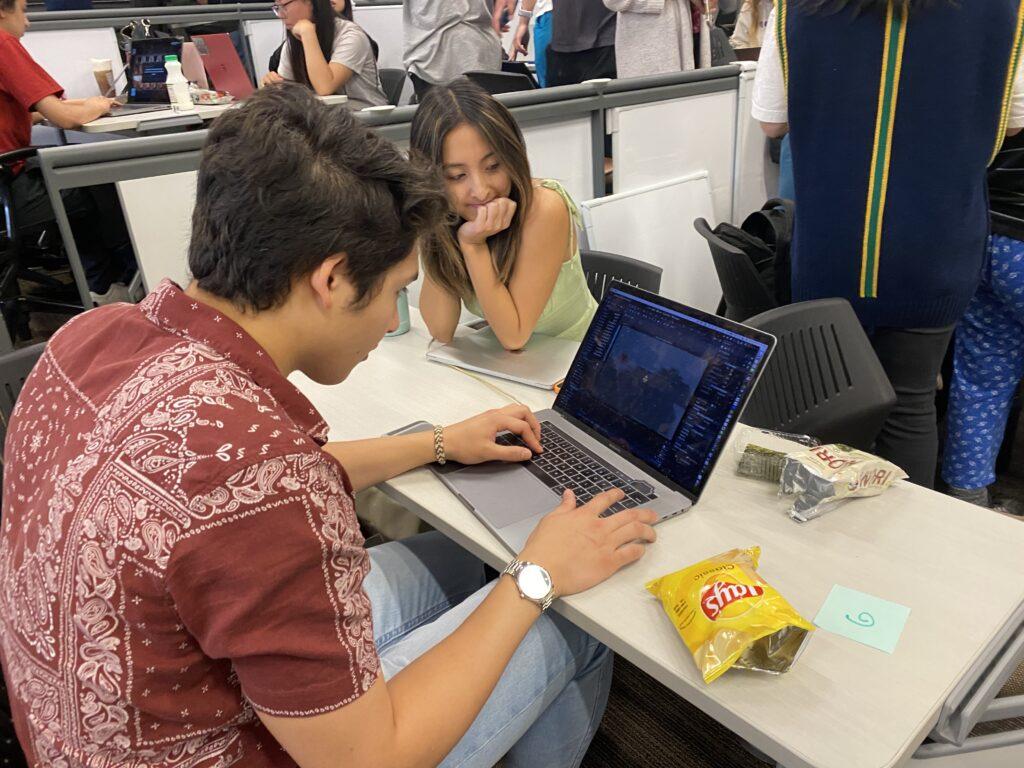
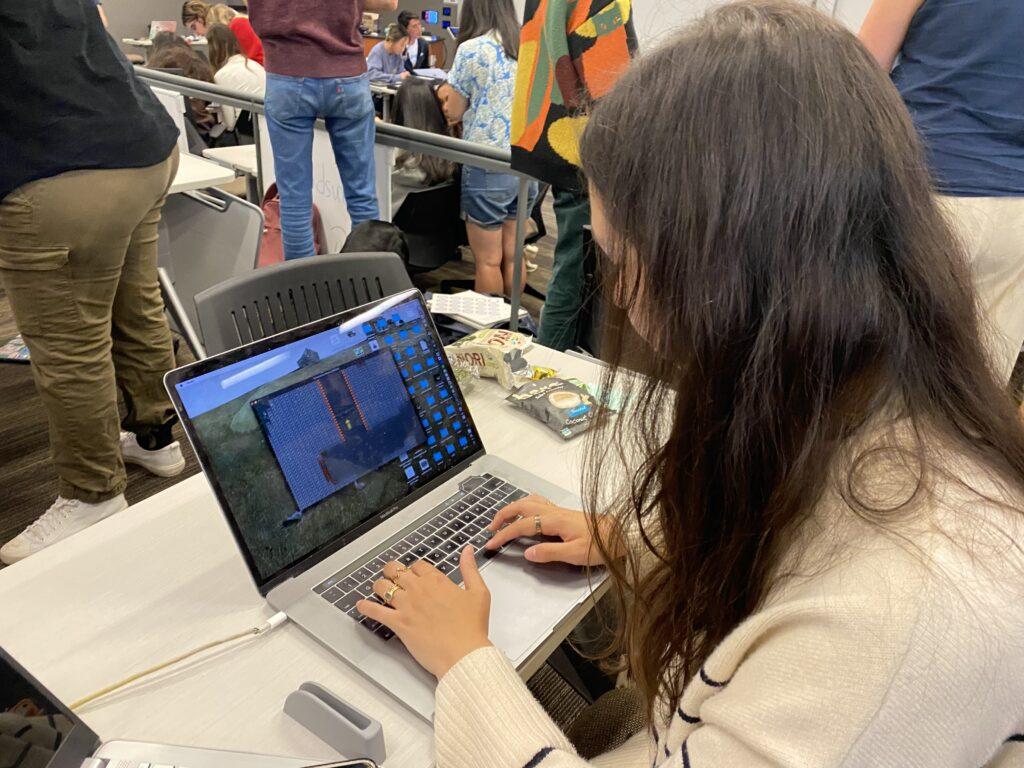
Other final playtesters in addition to one pictured in final video.
Areas for improvement in this playtest were mainly around making the game slightly more intuitive and solving the last few bugs. As the player gets the shield mid-level, we had no explicit dialogue explaining the use of the shield and the instructions were relatively limited. This led to confusion amongst the players for how exactly to use it. We also ran into a bug with dialogue where the text would stay at the bottom of the screen and block part of the screen while players had to platform.
Ultimately, we feel as a team that this is a final product that we’re proud of. The goals we set out were accomplished in the final playtest. First, our goal to create a challenging puzzle-platformer with interesting mechanics was a hit; through careful level design that forces users to combine multiple platforming mechanics into fluid movements, we challenge players to think creatively about how they can combine these maneuvers and push their physical dexterity in accomplishing these actions that require quick reaction times and precise movements. In tandem, we were able to tell a story from a culture left out of most big budget game studios, fulfilling our team’s value of sharing unique narratives as well as simply making the game more engaging and interesting for players.
Game Analysis
The major kind of fun found in our game is challenge. Through platforming, puzzle-solving, and combat, there’s a series of new challenges for the player to work through and complete, resulting in ultimately satisfying fun after having beaten difficult tasks. Also incorporated in the game is narrative as our player is immersed in a story that unfolds throughout the game. Depending on how immersive the player feels the story is, the fun may even devolve into fantasy as they truly feel like they’re Apu.
To create these aesthetics, we can look at the dynamics of the game that creates these kinds of fun. The major driver behind the gameplay is the user’s experimentation with the abilities available to them at any one time. This optionality presents multiple ways to go about solving a puzzle, adding to the challenge of the game while keeping it fresh. As the game progresses through solving puzzles, a positive feedback loop is created by introducing story elements that add on a layer of motivation to completing levels. These two dynamics work in tandem of explorative play and narrative discovery to create a fun experience for the player that continues to feel fresh throughout their game playing experience.
In order to make these dynamics possible, the game itself has a series of mechanics that provide the framework of the magic circle itself. The main mechanic is the physics of the game and abilities of the player. The player’s movement is restricted to a set of actions such as running, jumping, double jumping, and dashing that create the base options for solving the puzzles. These actions are placed within levels designed to match the physics of the game, ultimately creating possible but difficult routes throughout the game. As these elements work together, they’re able to create challenging, satisfying platforming puzzles that ultimately create multiple kinds of fun for the player as they progress through Apu’s Return.


